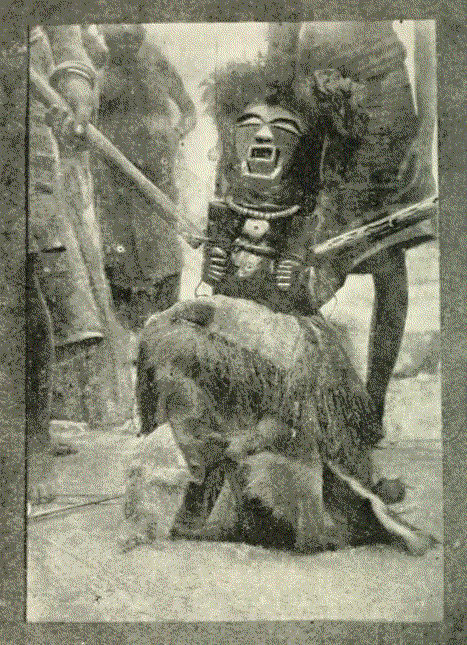
After yesterdays Luba chief, another amazing field-photo from Missionary pioneering in Congo forests: a narrative of the labours of William F.P. Burton and his companions in the native villages of Luba-Land(p. 188): a Songye figure, “the famous fetish of Kabashilange”, in full action. Burton, still exploring the Luba-Songye region, writes in his diary:
Arriving at Kabashilange, our stopping place, a village of about 250 people, we found ourselves in the centre of a considerable crowd doing honor to their far famed ‘Nkishi’ or idol, named Tombwe, which was made by four powerful magicians at a price of 200 francs and a woman. The woman, frightened to become the wife of a magician, ran away, but was brought back and forced into submission, though screaming and almost incoherent in her terror
This tiny bit of information proves already to be very informative. It confirms, once more, that each Songye statue had a personal name. This is the first reference I’ve come across of a figure being ‘made’ by four diviners. Unfortunately that ‘made’ isn’t specified; Burton probably meant ‘activated’ and it’s not clear if one of the four was also the sculptor. Also note how even a small village of 250 people did have (at least) 4 diviners. Burton continues describing ‘Tombwe’:
The ‘nkishi’ is about two feet six inches high. A wooden figure covered with charms, etc. It is carried about by two women, who may not touch its sacred person, but hold it by two long poles attached to its arms. Moreover as it is carried, a drum and rattle band is in attendance, while little girls sweep the ground before it, as it stood upright, with grass cloth bundles filled with magic charms. The father of a certain native Songye, was lost, and the idol was paid a big sum to find him. The poor tired woman attendants dragged it uphill and down dale, through stream and forest, now and again professing to get on the scent, but in vain.
I knew the functions of these power statues were varied, but I had never read they were also used to find missing persons. What is especially noteworthy about this description is the fact that the statue couldn’t be touched and was carried by long poles attached to its arms – a known fact. This explains why you will see the connoisseur evaluating a Songye power figure looking at the arm pits of the statue: a well used authentic example will show a notable wear caused by the ropes connecting the poles to the figure under the arms.
Unfortunately, I wasn’t not able to discover the current location of Tombwe – it is even not sure if he ever left Kabashilange..
ps you can browse (or download) that 1922 Burton book here – there’s plenty more to discover!